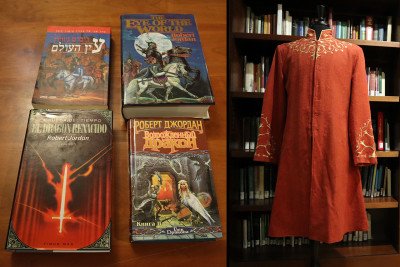Current Exhibits
Cornbread and Challah: Exploring Southern Jewish Foodways
October 2023-Present

From Kaluszyn to Carolina: The Kalushiner Society in Charleston
May 2024-Present

Robert Jordan’s “The Wheel of Time”
Fall 2021-Present
This exhibit features materials from the author’s vast body of work, including literary drafts in various states of revision, correspondence, photographs, promotional materials, prop weapons, costumes, and personal effects.
On Display in Special Collections, Addlestone Library

John Rivers Communication Museum
September 2018 – present
A splendid showcase of media objects from the collections of the John Rivers Communication Museum.
Featuring College of Charleston faculty publications, this rotating display showcases a small selection of the scholarly work of the College of Charleston faculty members. Copies of most of these books are in the stacks and available to be checked out to members of the campus community (or purchase in the CofC bookstore).


